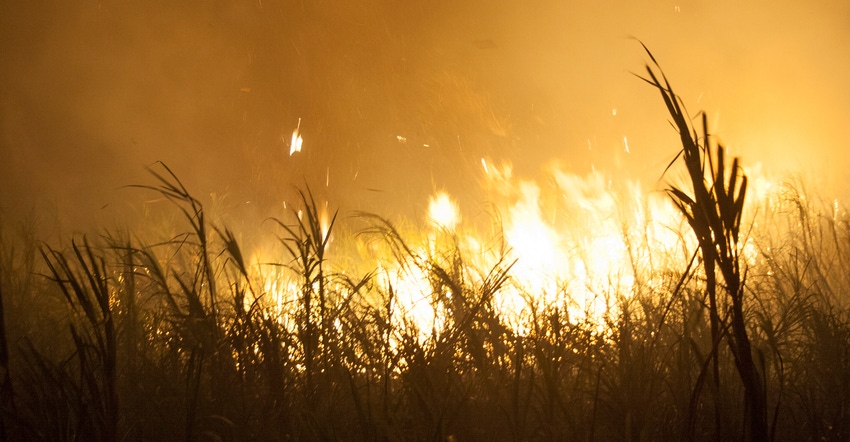October 6, 2017

Dry corn and soybean fields have put farmers at greater risk of their combines catching on fire while harvesting crops.
At least three combine fires were sparked across Ohio in one week. Two happened during the weeklong heatwave: one in Crawford County on Sept. 22, and another in Miami County on Sept. 24. A third combine fire happened Sept. 28 in Shelby County, which left a man with serious burns, according to news reports.
Combines can catch fire when the dry plant material or grain dust mix with heat generated by the combine’s motor, belts or exhaust system, or by the static electricity produced as the combine is driven through a field, says Rory Lewandowski. He is an agricultural and natural resources educator for Ohio State University Extension.
Every year, harvest comes with some risk of combine fires, but this year was especially dry, so the risk is higher than usual, Lewandowski adds.
Having machinery equipped with a trustworthy fire extinguisher is one of the first lines of defense against field fires, says Dee Jepsen, state safety leader for OSU Extension.
Combines should carry an ABC 10-pound fire extinguisher, while tractors are recommended to have a 5-pound unit. Every vehicle in the field should have a fire extinguisher, she says.
"Nothing is worse than watching the combine go up in flames while you're running to the end of the field to retrieve the fire extinguisher on the grain cart,” Jepsen says.
Another safety measure is to attach a chain to the frame of the combine and allow it to drag along the ground, which can reduce the buildup of static electricity, Lewandowski explains. Clearing away chaff from various parts of the combine could also reduce the odds of fire.
“We wouldn’t have near the risk of fires if we were harvesting under wet conditions,” he says.
The weeklong heat wave that began Sept. 21 and ended Sept. 27 included multiple record-high days, according to Aaron Wilson, climate specialist for OSU Extension.
In the first half of September, temperatures averaged 2 to 9 degrees below normal; then in the second half of the month, the mercury rose. During the heat wave, the northern part of Ohio was 12 to 16 degrees above normal, and the southern part of the state was 8 to 12 degrees above average.
“It’s a pretty extreme shift,” Wilson says.
Though the weather has cooled significantly, not much rain is expected in the next couple of weeks, he says.
Additional safety tips to avoid a combine fire include the following:
• Keep machinery in good repair. Apply grease to bearings and oil chains regularly to reduce friction. It is advisable to perform maintenance checks at the end of the day, rather than at the beginning, to detect any hot or smoldering areas that may break out into flames overnight.
• Keep machinery clean and free of plant materials, especially around the wrap points. Wipe up any fuel or oil leaks to eliminate additional fuel sources, and do not leave oily rags on equipment or in the cab.
• Take time to cool down the equipment each night, and check for any hot spots.
Source: OSUE
You May Also Like




